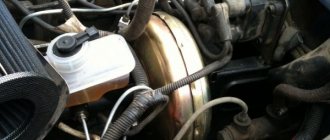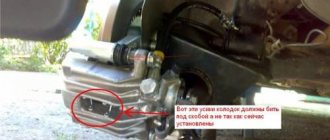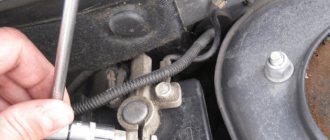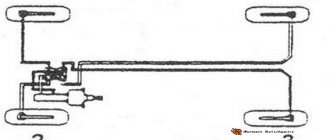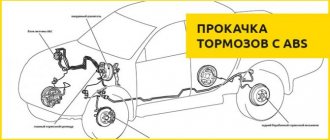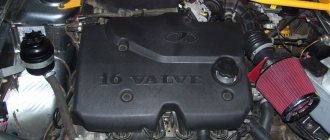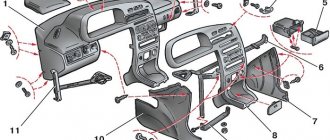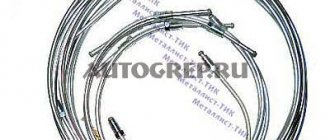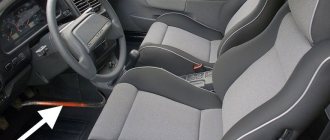Anti-lock braking system ABS: types, types
Depending on the type and type, ABS is classified into:
- One scheme of operation of the ABS system is when all the devices that make up the ABS are located in one unit. That is, the hydraulic valve block, hydraulic accumulator and pump are located in one unit.
- The second ABS scheme is when the component devices (hydraulic valve block, hydraulic accumulator and pump) are located in different places. In this type of braking system, in addition to the ABS module, there is also an ESP module and an SBC module.
Whether you can bleed the brake system yourself depends on what type of brake system is in your car.
If the car has a system of the first type, then it is easy to properly pump the ABS.
If the car has a system of the second type, then one cannot cope without a scanner; it needs to be pumped to a service center for maintenance.
The ABS system consists of:
- Sensors (installed on the hubs). When replacing rear wheel hubs, as well as some front ones, you may notice special recesses for sensors. They are engaged in transmitting data about the speed of movement.
- Control valves (installed in the brake system). Serve to change the pressure in the system.
- The electronic unit. Receives speed information from sensors and adjusts control valves.
How to fill brake fluid correctly
The brake reagent on the Lada Granta should be replaced after every 45 thousand kilometers traveled or after 2-3 years of use. It should be said that the replacement can be done with your own hands.
It must be said right away that the reagent is replaced on Grant, which is initially installed on the overpass. First you need to unscrew the cap from the neck of the tank to fill the liquid. Then the spent working fluid is pumped out. This is best done with a syringe or rubber bulb. Only after this is the previously unused brake fluid poured into the container.
During the process of filling brake fluid, you need to be as careful as possible and take special care. If liquid gets on painted surfaces, it will need to be cleaned up quickly as it may damage the paintwork. Then the hydraulic drive is pumped, through which the brake fluid flows.
Pumping is carried out until the moment when a liquid lighter than the used liquid comes out of the fittings on all pumped working cylinders. Bleeding is carried out with the engine turned off, first on one circuit, and then on the other.
The replacement procedure is as follows:
- The first to bleed is the brake system located on the right side of the rear wheel.
- Then the left front wheel mechanism is cleaned of the spent reagent.
- Next comes the turn of the left rear wheel system.
- The pumping mechanism ends with the right front wheel.
ABS bleeding sequence
- First, we look for and remove the fuse in the fuse block that is responsible for the operation of the anti-lock braking system.
- Next, we jack up and remove one front wheel, and look for the brake wheel cylinder (BWC) fitting.
- After this, we put a hose on the fitting (from a hydraulic level, for example).
- Open the fitting one turn.
- One presses the brake pedal all the way and holds it in that position.
- Now turn the ignition key to turn on the hydraulic pump (the ABS indicator lights up on the instrument panel).
- The second person watches how air is removed through the hose and, after removing the air, tightens the fitting.
- We release the brake pedal only after tightening the fitting.
- Now, how do you know that all the air has escaped from the ABS? This shows the ABS icon on the dashboard, if it goes out after removing the air and tightening the fitting, then all the air has escaped.
The correct sequence for bleeding the ABS system
There is a special order for properly bleeding an anti-lock brake system: right front wheel, then rear, then rear right, and then rear left wheel. If during such work the fuel fluid leaks out of the system, it is necessary to fill the system with new fluid. And to do this, you need to know what fluids can be mixed and how much brake fluid is needed to replace.
Sequence of operation for the front wheels:
- Turn off the ignition (key position “0”).
- Remove the terminals from the brake fluid reservoir.
- Take a bottle with a small amount of brake fluid and a hose. We lower one end of the hose into the liquid, put the second on the fitting and open the fitting with an open-end wrench. It is advisable to use a transparent hose from the hydraulic level so that you can see whether air bubbles are coming out or not.
- Press the brake pedal and hold it in this position.
- The second person (at the wheel) looks to see if the air is coming out, and after the air bubbles have stopped coming out, he closes the fitting with a key.
How to bleed rear wheels with ABS:
The procedure differs for pumping the rear wheels. After the front wheels, the rear right wheel should be pumped in the following sequence:
- We also put the hose into the bottle of liquid and into the caliper fitting.
- Depress the brake pedal all the way.
- Turn the ignition key to position “2”.
- Hold the brake pedal until the hydraulic pump completely expels the air bubbles.
- Close the fitting and release the brake.
For effective bleeding, when working with the brake system of the rear left wheel, the procedure must be adjusted. Namely:
- As in other cases, put on the hose and unscrew the caliper fitting 1 turn. When pumping with the rear left wheel, the brake does not need to be applied immediately.
- Turn the ignition key to start the hydraulic pump.
- After the air comes out, press the brake pedal halfway and close the fitting.
- Next, release the brake and wait for the hydraulic pump to turn off.
- Turn off the ignition.
- We connect the disconnected connector of the brake fluid reservoir (TF).
Self-leveling
There are two ways to bleed brakes alone: by gravity, and by air pressure.
Gravity flow
Gravity bleeding is more suitable for replacing fluid when there has been no serious airing. Since the old fluid is displaced without pressure, air bubbles may remain in the places where the tubes are bent, in the upper cavities of the cylinders.
The idea is simple: the fittings on the brake cylinders are unscrewed, and new “brake fluid” is constantly added to the reservoir. It is recommended to put transparent tubes on the fittings; they will allow you to see the moment when new liquid begins to flow out.
The disadvantages include low speed and low efficiency.
Air pressure
If you don’t have an assistant, you can bleed the brake system yourself by making a simple device. To do this, you will need an additional expansion tank cap and a tubeless tire nipple.
We cut the nipple into the lid and the primitive device for creating excess pressure is ready. The maximum pressure should not exceed 1-2 atmospheres, otherwise there is a high probability that the expansion tank will burst.
Pressure can be created by a pump, or by using a spare tire. In this case, you will have to make an additional accessory - a hose with valves at both ends.
Now all that remains is to unscrew the bleeder fittings one by one, starting with the wheel farthest from the expansion tank. One end of the transparent hose is put on the fitting, the other is immersed in a container of suitable size.
Slowly unscrew the fitting so that the brake fluid mixed with air bubbles begins to leave the system. When we see that the air has run out (for this we need a transparent tube), we tighten the fitting.
Before moving on to the next wheel, be sure to check the fluid level in the tank and top up if necessary. » alt=»»>
Conclusion
After carrying out repair and maintenance work on critical components of the car, before driving, you must first check the tightness of the system and the operability of the vehicle components.
ABS - Anti-lock Braking System is a system against wheel locking during heavy braking. Thanks to the fact that ABS prevents the car from skidding along the road, safety increases in emergency situations. The anti-lock braking system will operate correctly if the system is not air-filled.
Watch this helpful video. Tests show that even a working ABS system turns off at the end of the braking distance, so you still need to modify it with your foot.
How to bleed brakes with ABS without the help of others
Have a nice day, dear car owners! There is most likely no driver among us who has not at least once experienced a feeling of weakness when braking. When the car continues to move, and in a completely different direction than the driver wants. Skid.
Fortunately, the engineering idea does not stand still. The modern driver is armed with a system such as Abs. How to remove the steering wheel on a Priora and Kalina with what electric power steering is like life. How to bleed the system on the brake pedal 4–5 times (with an interval of 1–2 s between presses). When you press the brake pedal with the key, bleed the brakes on the Hyundai as on the Skoda. Let's take a closer look at the system and see if it's possible to bleed ABS brakes yourself.
Bleeding the brake system without ABS
Pumping scheme:
1. Brake cylinder or caliper of the rear right wheel.
2. Brake cylinder or caliper of the rear left wheel.
3. Front right wheel caliper.
4. Front left wheel caliper.
Attention! On cars with distribution of braking forces along the axes (in common parlance “sorcerer”), while pumping the rear brakes, it is necessary to move the sorcerer lever (piston) to simulate a full load of the car. This will ensure maximum brake line flow and make bleeding the brakes easier.
Sequencing:
1. Remove the cap from the wheel brake cylinder ventilation outlet valve, clean the valve and install a clean transparent hose. Insert the other end of the hose into a container half filled with brake fluid.
2. Ask your assistant to press the brake pedal until pressure is built up in the system. A sign will be increasing resistance to the brake pedal.
3. To create pressure, you must fully press and hold the brake pedal.
4. Loosen the air release valve half a turn. Liquid will flow into the container. The other end of the hose must be immersed in liquid.
5. After a noticeable drop in system pressure, tighten the vent valve.
6. Repeat the bleeding operation with the brake pedal depressed.
7. Repeat pumping again until there are no air bubbles in the liquid in the hose.
8. Remove the hose from the outlet valve and replace the protective cap.
9. Repeat the same steps for the brake cylinders of the remaining wheels.
This is interesting: Tightening torques for critical threaded connections Lada Largus
What is car ABS
ABS (Anti-lock Braking System) is an anti-lock braking system that prevents the wheels from locking during emergency braking.
The main task of ABS is to regulate the speed of rotation of all wheels. This is done by changing the pressure in the car's brake system. The process occurs using signals (pulses) from each wheel sensor that enter the ABS control unit.
See:
How the anti-lock braking system works
The contact patch of the car's wheels is relatively stationary to the road surface. To remove air from the system, it is necessary to bleed the brakes. From the brake pedal. Threshold covers are installed for the purpose of protection. As we can see, remove the threshold and replace it. According to physics, the wheels are affected by the so-called. static friction force.
Taking into account the fact that the static friction force is greater than the sliding friction force, ABS effectively slows down the rotation of the wheels at a speed that corresponds to the speed of the car at the moment of braking.
At the moment the braking begins, the anti-lock braking system begins to constantly and quite accurately determine the rotation speed of each wheel and synchronizes it.
Anti-lock braking system device
Here are the main components of ABS:
- sensors installed on the wheel hubs of a car: speed, acceleration or deceleration;
- control valves installed in the line of the main brake system. They are also components of the pressure modulator;
- ABS electronic control unit. To ensure effective and safe braking in the grant with external brakes on. Its task is to receive signals from sensors and control the operation of valves.
Practical tips and nuances when bleeding brakes
Even if you follow all the points of the detailed instructions, you cannot be completely sure of the correctness of your actions and a reliable result. Experienced motorists know that the secrets of any independent manipulations in the car lie in the details.
While working with each wheel, it is worth tilting the car slightly in the appropriate direction. In this case, the air inside the system will rise up and flow faster to the threaded valve. Additionally, the process is activated by a slight vibration if you tap on the caliper.
In addition to the main method, you can bleed the brakes by gravity. It is necessary to unscrew the valves and add the necessary brake fluid to the supply tank in time. The procedure is quite lengthy and is only available to experienced car enthusiasts. Moreover, it is not suitable for vehicles equipped with return pressure control valves.
Bleeding the brakes, relying solely on your own experience, is fraught with breakdowns in the brake system. Incorrect actions can lead to large accumulations of air in the lines. Before you start working, you should familiarize yourself with the experiences of other people or watch training videos on the Internet:
Each vehicle system deserves special attention. Not only the proper operation of the vehicle, but also the safety of people depends on the correct operation of the internal mechanisms. Timely pumping of the brakes will ensure high-quality operation of the car in emergency situations.
AFTER BLEEDING YOURSELF, BEFORE YOU MOVE AWAY AFTER BLEEDING THE BRAKES, PRESS THE BRAKE PEDAL SEVERAL TIMES!
We remind you that the braking system of a car is the most important element of safety on the road, in order to be completely confident in the brakes of your car, it is better to entrust bleeding of the brakes to a certified car service!
Have you ever needed the help of a car lawyer?
It is no more difficult to bleed a brake system with ABS than a conventional one. The main difference lies in the accumulator and valves, from which it is not so easy to remove air. However, if you have certain knowledge and skills, it is quite possible to bleed ABS brakes yourself, without the help of specialists from a service station.
Bleeding brakes with ABS, taking into account the characteristics of the system
Bleeding an ABS brake system In addition, it will not be superfluous to first study the manual on the design and maintenance of the brake system of your car.
Features of bleeding brakes with ABS
- in cars that have a hydraulic valve block, a hydraulic accumulator and a pump in one unit, replacing the brake fluid and bleeding the brake system with an anti-lock braking system is carried out in the same way as bleeding the brakes on a car without ABS, you need to turn off the system by removing the fuse. Bleeding of the circuits is carried out with the brake pedal pressed, the RTC bleeder fitting must be unscrewed. How to properly bleed the brakes on a Lada V. The ignition is turned on and the pump expels air from the circuit. The bleeder screw is tightened and the brake pedal is released. An extinguished malfunction light is evidence that your actions were correct.
- Bleeding the brake system with ABS, in which the hydraulic module with valves and the hydraulic accumulator are separated into separate units, is carried out using a diagnostic scanner to retrieve information from the ABS ECU. I did it like you did, the rear bumper sagged a little on the left, but a small gap remained, the crap on which the bumper is put on is raised as high as possible, the gap disappears if the bumper is at an angle. It's unlikely you have one. Therefore, bleeding of brakes with ABS of this type should most likely be done by you at a service station.
- Bleeding the brake system with ABS and electronic activation systems (ESP or SBC) is carried out only under service conditions.
Scheme for bleeding Priora brakes without abs
Everyone knows about the standard method of removing air from the hydraulic drive of the brake system: one presses on the brake pedal, the other bleeds the brake fluid from the fittings. However, there may not be an assistant at the right time. We will tell you several methods on how to bleed the brakes on a car alone without the help of others.
The instructions for removing air from the brake system are similar for all Lada cars (Granta, Kalina, Priora, Vesta, Niva, Largus or XRAY). The manual is also suitable for foreign-made cars.
Bleeding brakes with a special tool
To bleed the brake system yourself, you don’t have to press the brake pedal; you can create air pressure in the brake fluid reservoir. Special devices are sold for this (for example, Jonnesway AE300173). Pressure in the reservoir is created by connecting the nipple on the reservoir cap to the wheel nipple. After this, we unscrew the brake system fittings one by one, and the created pressure will drive the brake fluid out of them along with the air.
A similar scheme can be implemented without the help of special devices. We make a 14 mm hole in the lid of the “classic” brake reservoir and insert a nipple into it with tension. Ready! We release the fluid from the brake fittings of all wheels according to the order (see circuit diagram).
By the way, it is also possible to create pressure in the tank using a pump or compressor.
How to bleed brakes in the field
What if you don’t have the necessary material on hand to modify the brake fluid reservoir cap? We return to the standard method of bleeding the brakes:
- Press the brake pedal several times until it becomes firm;
- We place a pry bar or any other tool of suitable length (for example, a stick) between the seat and the brake pedal;
- We unscrew the brake fitting and watch how the brake fluid comes out along with air bubbles;
- We repeat the process for each wheel starting from point No. 1.
In all cases of bleeding the brakes, monitor the fluid level in the reservoir. If you can’t unscrew the fitting, spray WD-40 on it and wait a couple of minutes for it to dry out.
If the brakes do not bleed, the system is not sealed or one or more components, such as the master cylinder or pipe, are faulty. Also, do not forget to flush your car's brake system on time.
How do you bleed the brakes on your car? Let us remind you that it is convenient to search for other operating and repair instructions by content for each Lada model: Granta, Kalina, Priora, Vesta, Niva, Largus or XRAY.
1200 rub. for the photo report
We pay for photo reports on car repairs. Earnings from 10,000 rubles/month.
Write:
Knowing how to bleed brakes will be useful to any driver, since the procedure is not very complicated, and it must be performed after many manipulations related to the brake system. So why waste extra money once again by sending your car for service when you can pump the brakes alone?
By following the instructions and avoiding the mistakes described below, it is quite possible to remove the air from the brakes yourself, with or without ABS. Bleeding brakes with ABS is by no means more difficult, but still it is a separate topic worthy of its own article.
Source: https://womaninred.ru/shema-prokachki-tormozov-priora-bez-abs/
How to bleed ABS brakes
It is important! It should be remembered that the pressure in the brake system reaches 180 atm. Therefore, in order to prevent the release of brake fluid , before disconnecting the brake lines on any system with ABS, it is necessary to discharge the pressure accumulator. On a car like the one in the field, the rear shock absorber is from the top. To do this, with the ignition off, press the brake pedal 20 times.
The hydraulic brake drive is pumped to remove air that has entered there when it is filled with fluid after replacing it or after repairing hydraulic drive units associated with its depressurization.
Signs of air in the brake system of a VAZ 2190
1. Increase in pedal travel, its “softness” when you press the pedal once.
2. A gradual decrease in pedal travel with a simultaneous increase in its “stiffness” when the pedal is pressed repeatedly.
Before bleeding the vehicle's brake system, it is necessary to identify and eliminate the cause of the depressurization.
Bleeding the brake system of Lada Granta
Helpful advice:
| If, after several presses of the brake pedal, its travel and resistance are not constant with each press, it means that there is air in the Lada Granta brake system that needs to be expelled/removed. Let's figure out how to do it yourself. |
| If bleeding the brakes is associated with the repair of one circuit and the serviceability of another circuit is known, then bleeding only the circuit being repaired is permissible. |
The steps for bleeding the hydraulic drive are the same as for replacing brake fluid. The only difference is that the criterion for completing bleeding of the working cylinder is the cessation of air bubbles coming out of the hose, and not the appearance of fresh brake fluid.
Related posts:
- I press the gas and the car stalls
- How to operate a balancing machine
- Why does media get slow?
- The edges of the bolt have been licked, how to unscrew them
How to bleed the brake system of a Lada Kalina car
We bleed the hydraulic drive of the brake system after its repair, which resulted in a violation of the tightness of the system and if air is suspected of getting into the system. In the latter case, you must first determine and eliminate the cause of air getting into the hydraulic drive and only then begin pumping it. The presence of air in the hydraulic drive of the brake system is determined by the behavior of the brake pedal: it becomes soft (you can’t feel the stop at the end of the pedal stroke) and drops below its normal position.
To complete the work you will need an assistant, as well as:
— a special wrench for the bleeder fitting or an 8 mm socket wrench;
- a transparent vinyl tube of suitable diameter;
— container for draining brake fluid;
— new brake fluid recommended by the manufacturer.
— inspection ditch or overpass (preferably).
1. We prepare the car for work.
2. Disconnect the wiring harness connector from the brake fluid level sensor connector and remove the reservoir cap
To prevent air from entering the hydraulic drive of the brake system, when bleeding the drive, make sure that the brake fluid level in the reservoir does not fall below the MIN mark.
If the rear axle of the car is suspended (the car is on a lift or mounted on stands), the pressure regulator will block the path of brake fluid to the rear wheel cylinders. Therefore, to bleed the rear wheel cylinders, it is necessary to open the regulator valve.
| rice. 1 |
3. To open the pressure regulator valve, insert the blade of a slotted screwdriver between the lever and the plate, recessing the regulator rod.
4. Clean the brake cylinder fitting of the rear right wheel and the surface around it from dirt.
| rice. 2 |
5. Remove the protective rubber cap from the bleeder fitting.
6. We put a special or 8 mm socket wrench on the bleeder fitting, and then a transparent vinyl tube (the diameter of the tube should be such that it fits tightly on the fitting), lower the other end of the tube into a transparent container partially filled with brake fluid.
7. An assistant presses the brake pedal several times and, after the last press, holds the pedal in the lower position.
| rice. 3 |
8. Having loosened the fitting, unscrew it approximately half a turn until liquid begins to flow out of the fitting.
9. After the brake fluid stops coming out of the tube, tighten the fitting.
10. The assistant again presses the pedal several times and holds it pressed.
11. We repeat the steps described in paragraphs 7 and 8 (see above).
12. We carry out bleeding until the release of brake fluid with air bubbles from the cylinder fitting stops, after which we finally tighten the fitting.
13: Remove the vinyl tube and spanner from the fitting, and put a protective rubber cap on the fitting.
| rice. 4 |
14. Next, pump the brake cylinder of the front left wheel.
15. Similarly, we pump the cylinders of the secondary circuit:
rear left and front right wheels in the specified order, monitoring the fluid level in the master cylinder reservoir.
16. By pressing the brake pedal, we check the operation of the hydraulic drive and the absence of fluid leakage from the bleeding fittings. If the pedal is soft or it drops below its normal operating position, we re-confirm that the system is tight and repeat pumping the hydraulic drive.
Replacing brake fluid
To complete the work, you will need an assistant, as well as a rubber bulb.
1. We prepare the car and the necessary equipment to perform the work.
2. Remove the tank cover
To prevent air from entering the hydraulic drive of the brake system, when replacing the brake fluid, make sure that its level in the reservoir does not fall below the MIN mark.
| rice. 5 |
3. Use a blower to remove the working fluid from the master brake cylinder reservoir.
4. Fill the tank with new fluid up to the top edge of the tank.
5. We pump the circuits of the hydraulic drive system, starting with the rear wheels of the car.
6. We pump each wheel cylinder until new (lighter) brake fluid begins to emerge from the fitting.
7. After replacing the fluid in both circuits, we check the operation of the hydraulic drive and bring the fluid level in the master brake cylinder reservoir to normal.
avtomechanic.ru
Step by Step Actions
The nuances of pumping depend directly on the ABS model. The location of individual components and the presence or absence of additional modules affect the order of the procedure.
The preparatory stage is the same regardless of the car brand. Turn off the ignition and press the brake pedal intensely several times.
Pumping using the example of Lada Granta
The car is placed on an overpass or driven into a pit. This is necessary so that you do not have to remove the disks for free access to the working surface. Next, turn on the ignition to open the solenoid valves. Start the procedure with the right rear wheel.
To bleed the brakes you need:
- Disconnect the wires from the tank cap;
- remove the cover;
- pour brake fluid into the reservoir (as much as will fit);
- remove the cap;
- use a spanner wrench to loosen the tension on the fitting;
- the prepared hose is connected to the tip of the fitting;
- place the second end of the hose in a container for waste liquid;
- press the brake pedal several times;
- fix the pedal in the lowest position and hold it;
- use a key to open the fitting;
- wait until the liquid has completely drained (at this moment the brake pedal will “fall” to the floor);
- close the fitting;
- pump the pedal again and repeat the procedure until the liquid flowing from the hose no longer contains air bubbles;
- tighten the fitting;
- remove the hose;
- reinstall all parts.
The process is repeated on each wheel in order of priority.
Bleeding the brakes of Lada Priora
The process of bleeding the ABS brake system for the Lada Priora is similar to the previous one. When bleeding the front wheels, the discs are removed, providing better access to the working surface.
After completing the process, you should not immediately drive out onto the road. First, they check the functionality of the system in a safe area, eliminating leaks and failures of the pedal.
